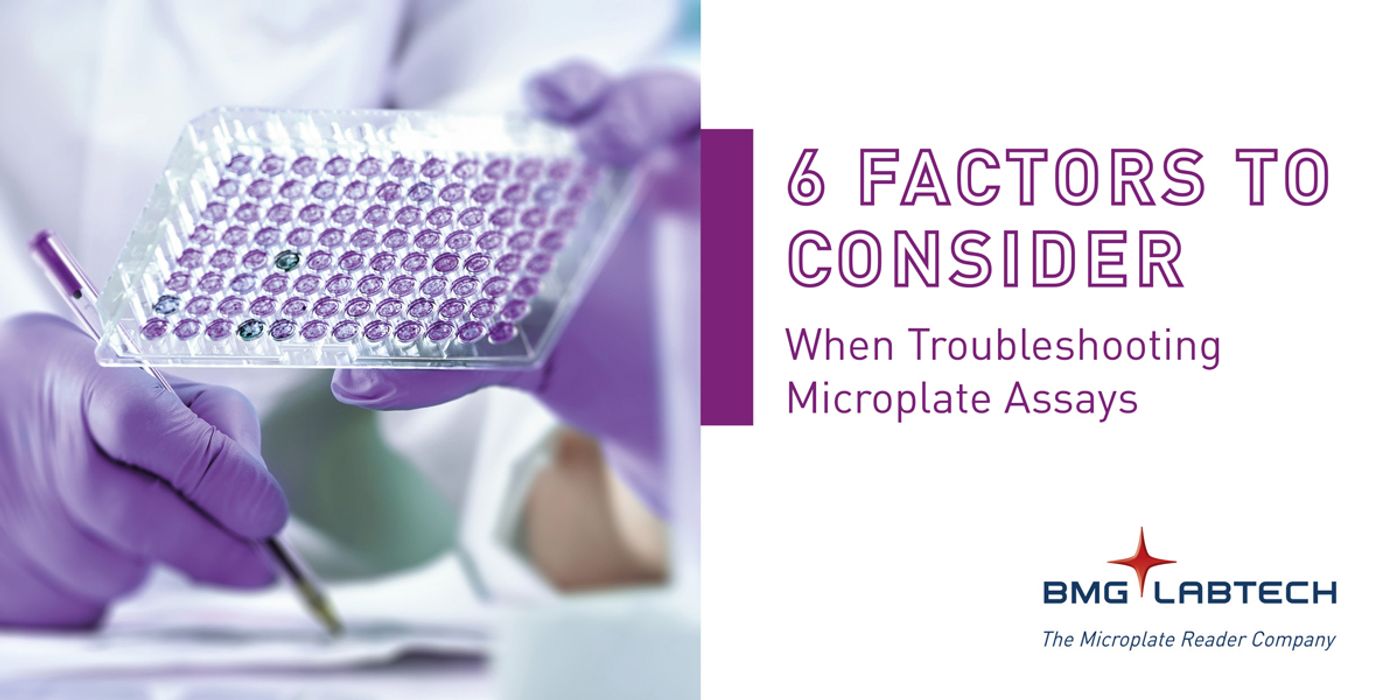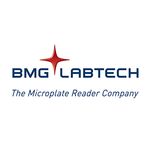6 Factors to Consider When Troubleshooting Microplate Assays
Microplate readers play a crucial role in the life sciences and biotechnology industry due to their ability to measure biological, biochemical or chemical reactions efficiently and in high throughput. Microplates have a variety of applications including DNA/RNA and protein quantification, enzyme kinetics, Enzyme-linked Immunosorbent Assays (ELISA), determination of cell viability, drug screening and gene expression analysis. To avoid unnecessary measurement repetitions and to prevent additional costs researchers require high data accuracy when performing research assays.
Like all scientific instruments, microplate readers are highly complex devices that can quite sensitively react on incorrect settings and sample preparation. Despite their powerful benefits, the consequences of improper use or of a poorly optimized assay include the inability to detect any signal, misleading results (e.g., false positives or false negatives), and inconsistent readings on the very microplate or between experiments. The good news is that steps can be taken to prevent and troubleshoot these common issues that will advance scientific research and productivity.
Founded in 1990 in Germany by Dr. Bela Gurath, BMG Labtech has grown from a one-person operation to a global leader in microplate reading. After more than 30 years in the business, BMG Labtech is today the only independent manufacturer solely focused on microplate readers.
Understanding Micropate-Based Assays

Fig. 1: Different available microplate colours.
Microplates come in a diverse range of colors (black, white, clear, and less commonly gray), materials (polycarbonate, polystyrene and cycloolefin) and well shapes (conical, round, flat bottom). The choice of the microplate is based on assay and detection requirements. If made improperly, it can negatively affect data quality and increase variability. For example, the different colors can influence signal-to-background ratios while different polymers influence light transmission.

Fig 2: Different microtiter plate layouts.
Along with colors and materials, microplates also come in a variety of layouts, including 6-, 12-, 24-, 48-, 96-, 384-, 1536-well, with 96-well as the most used. Additionally, while a 3456-well exists for even smaller sample volumes, this well type is rarely used. The well layout is determined based on the number of well arrangements in a microplate. For example, a 6-well microplate has a well arrangement of 2x3, a 12-well microplate has a well arrangement of 3x4, and so on.
Fundamentals of Microplate Readers
The key function of microplate readers is the ability to quantify the light output generated by liquid samples as a result of a biological or chemical reaction at a specific wavelength. Depending on the nature of the detection, light can be transmitted through the sample (absorbance), emitted upon excitation with a light source (fluorescence) or generated by a biochemical reaction (luminescence).
Microplate readers employ various types of light detection modes and are available as single-mode or as multi-mode instruments. The most common modes are absorbance, fluorescence and luminescence, with each providing their unique qualities to a myriad of scientific research applications.
To compliment the above scientific applications, functions, and modes, BMG Labtech offers customers several microplate reader options based on their scientific needs and funding requirements, including PHERAstar FSX, CLARIOstar Plus, VANTAstar, Omega Series, and SPECTROstar Nano.
Common Issues in Microplate Assays

Fig 3: BMG LABTECH single- and multi-mode microplate readers.
Microplate assays are still prone to different sources of variability, which may result from incorrect sample preparation, pipetting errors, differences in microplate batches, temperature variation, meniscus effects and uneven sample distribution in the wells. Some additional factors affecting assay reproducibility and reliability include sample quality, incubation time, and pH.
Troubleshooting Guide: Optimizing Upstream Assay Conditions
BMG Labtech emphasizes the importance of choosing the right microplate, specifically based on the colors described above (black, white, and clear, with gray being less commonly used), with each color enabling a different detection mode to be employed. For example, clear microplates are used for absorbance, white microplates are used for luminescence, and black microplates are used for fluorescence.
Additionally, it’s important to select appropriate well shapes and volumes based on your scientific research needs and limitations. While the 96-well is the most used, this choice is also based on the recommended volumes, which varies widely depending on the well size, ranging from 1 microliter (µL; in 3456-well plates) to 5 milliliters (mL; in 6-well plates). To achieve the most desired outcomes (i.e., accurate data), the standard recommended amount of liquid per well should be one-third of the maximum fill volume.
Troubleshooting Guide: Enhancing Detection Parameters
All scientific instruments require proper handling and preparation to achieve optimal data, and microplate readers are no different. Here below, you can find the 6 most relevant factors.
1. Wavelength/bandwidth selection

Fig 4: schematic of excitation and emission filters for fluorescein superimposed to their spectra. The highest transmitted excitation and the lowest transmitted emission wavelengths should be 30 nm apart.
Using the appropriate wavelength/bandwidth is vital for obtaining relevant data. These optical settings depend on the nature of the assay and on which detection mode is used for the assays (absorbance, fluorescence, or luminescence). Improper excitation/emission wavelengths can decrease the signal output of your samples and increase background noise.
2. Number of flashes

Fig 5: Light source and detection system for fluorescence-based assays
In absorbance and fluorescence, the microplate reader quantifies the sample upon every excitation flash. Settings can vary from one to more than 100 flashes per sample measurement, depending on instrument and manufacturer. For optimal data, it is recommended to use as many flashes as possible for each sample. This helps reduce variability as the microplate reader automatically calculates the average of the values obtained with every single flash. However, consider that a higher number of flashes will increase the amount of time needed for the microplate reader to detect each sample.
3. Well-scanning

Fig 6: BMG LABTECH’s well scanning options include orbital, spiral and matrix scanning next to central measurements.
An uneven distribution of adherent cells, bacteria or precipitations can cause distorted results, given the fact that microplate readers typically measure just in the centre of the well. Well-scanning options ensure a larger well surface is analysed and deliver optimal results for all unevenly distributed samples. On BMG Labtech readers, this is accomplished through two methods: Matrix Scanning and Orbital or Spiral Averaging. For Matrix Scanning, the microplate reader obtains a scan with up to 900 points per well. Single data points or areas can then be selected or excluded from the calculation. For Orbital and Spiral Averaging, the plate reader obtains measurements over a circular or spiral track and calculates an average, resulting in optimal data results.
4. Focal height

Fig 7: Focal height curve on a microplate reader
Focal height is the distance between the sample and the detection system. As the signal intensity varies in the different planes of your sample, the setting of the focal height is crucial for optimum results. While adjusting focal heights on some models requires trial and error to determine the optimal result, BMG Labtech microplate readers are equipped with an auto-focus feature that automatically identifies the height at which the sample signal is at its highest.
5. Gain

Fig 8: Dynamic range of a microplate reader.
The gain is an artificial parameter applied to fluorescence or luminescence detection. It amplifies light signals at the detector side making differences more obvious. Incorrect gain settings lead to detector saturation or poor quality data. High gain settings apply a higher amplification and are required for samples with dim signals to separate them from blank signals. For bright signals, low gain settings are required as otherwise the detector will saturate, resulting in unusable data. Gain adjustment should be done on the highest signal in the plate, e.g., a positive control. On BMG Labtech readers, the Enhanced Dynamic Range (EDR) function eliminates the need for gain adjustments. The EDR technology provides automatic gain adjustment and covers up to 8 decades of signal intensity, making gain adjustments superfluous.
6. Integration time
This feature is mainly relevant in luminescence detection where it indicates the width (in milliseconds) of the time window in which light is collected from the sample. The longer the integration time, the more light is quantified, the higher the signal measured by the reader. Generally, longer integration times increase sensitivity, reduce data variability and increase data robustness. However, too long integration times increase the total measurement time and may also decrease the assay window.
BMG LABTECH features enhancing detection

Fig 9: BMG LABTECH’s patented LVF monochromator uses linear variable filters to the select light of distinct wavelengths and bandwidths.
Further to these optimization factors, BMG Labtech offers key features designed to enhance sample detection during an assay. These include LVF Monochromators with filter-like sensitivity, direct optic bottom reading, cross-talk reduction for luminescence assays, and the above-mentioned Enhanced Dynamic Range. All these additional features simplify detection and provide additional options to either increase sensitivity or to reduce data variability.
Conclusion
Here, we discussed the basic factors microplate reader users need to consider to get the best-possible data out of their microplate.
BMG Labtech has more than 30 years’ experience in manufacturing microplate readers and providing technical and application support to customers. For more details on optimization tips and microplate reader features, we invite readers to explore BMG Labtech’s resources, including the recently published “HowTo Notes”. Please feel free to contact BMG Labtech for any information regarding microplate readers at applications@bmglabtech.com.



![WGS for rare disease diagnosis [eBook]](https://d3bkbkx82g74b8.cloudfront.net/eyJidWNrZXQiOiJsYWJyb290cy1pbWFnZXMiLCJrZXkiOiJjb250ZW50X2FydGljbGVfcHJvZmlsZV9pbWFnZV84MmRlM2UyYjA5M2Q3ZTYwOTI3Zjc1YTRjOWU2N2RmMjkzMThjMTJkXzI1MDcucG5nIiwiZWRpdHMiOnsidG9Gb3JtYXQiOiJqcGciLCJyZXNpemUiOnsid2lkdGgiOjcwMCwiaGVpZ2h0IjozNTAsImZpdCI6ImNvdmVyIiwicG9zaXRpb24iOiJjZW50ZXIiLCJiYWNrZ3JvdW5kIjoiI2ZmZiJ9LCJmbGF0dGVuIjp7ImJhY2tncm91bmQiOiIjZmZmIn19fQ==)





